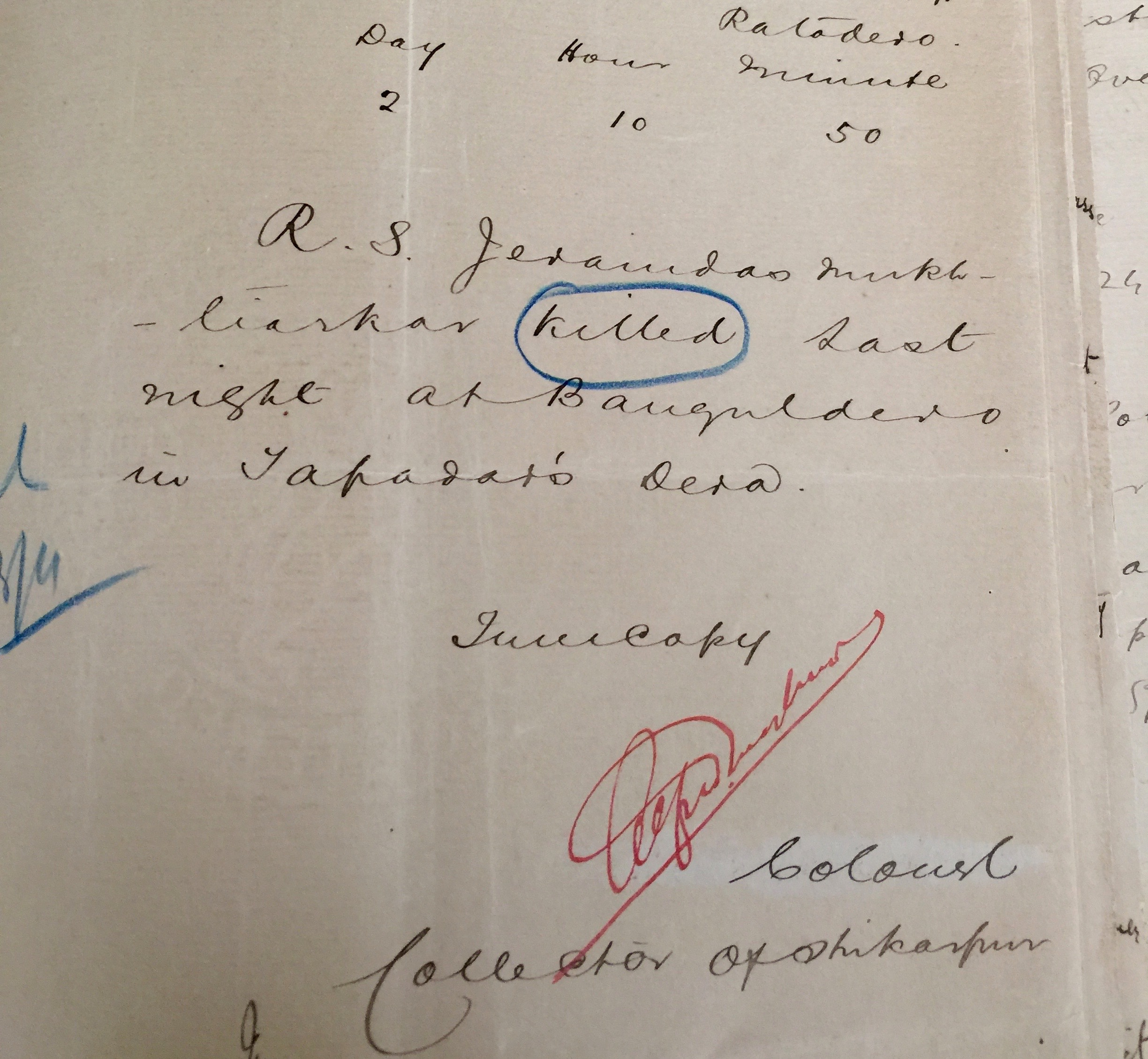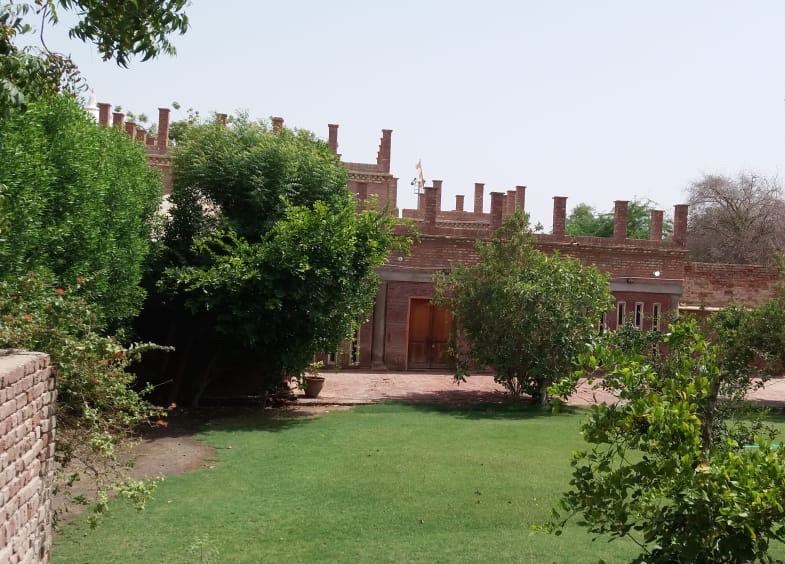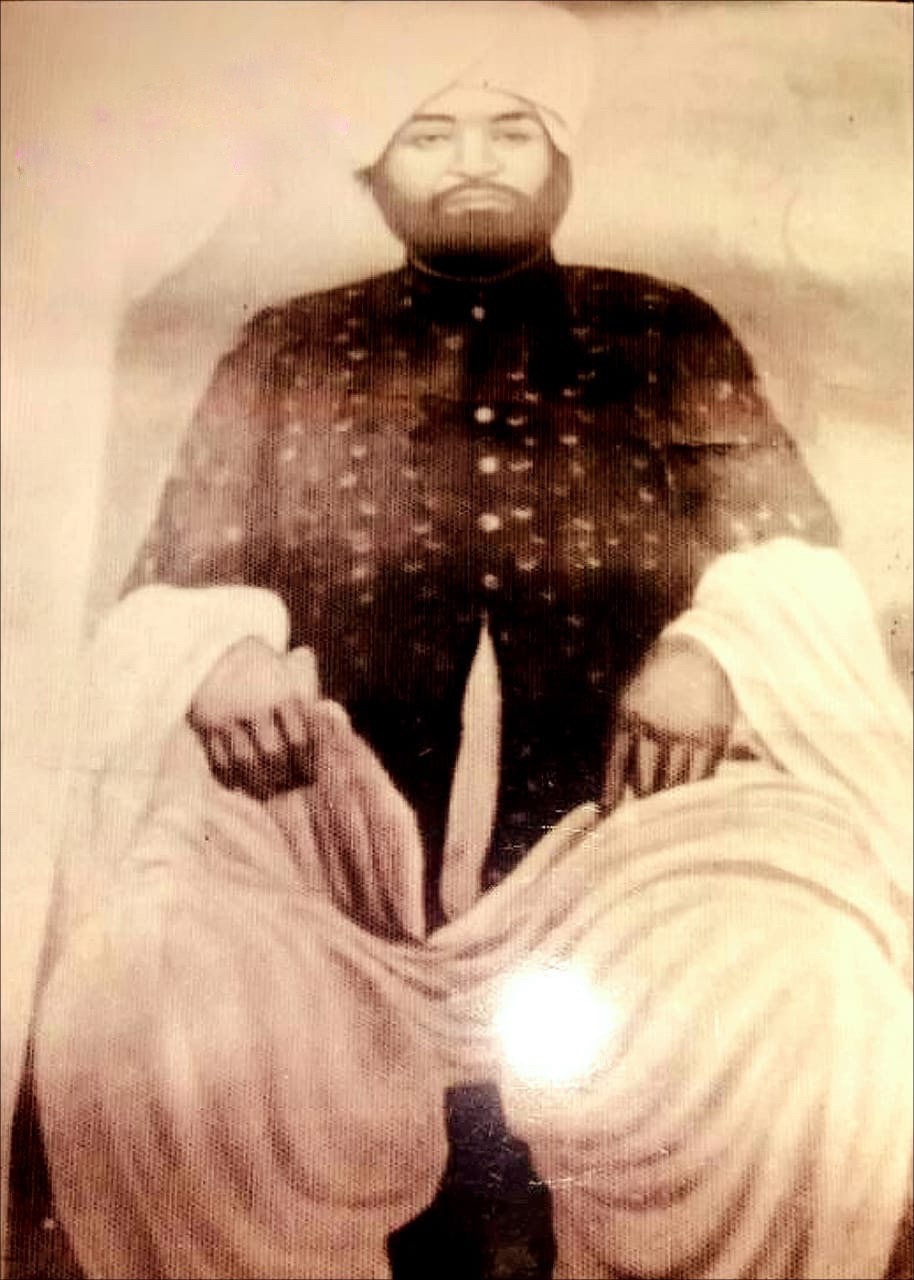Murder Ink
On November 2, 1896, Wadero Ghulam Murtaza Bhutto, grandfather of Pakistan’s former prime minister Zulfikar Ali Bhutto, boarded the 7:35am train from Naudero to Larkana. The young wadero was a grandson of Doda Khan Bhutto, the largest landholder in the Upper Sindh Frontier district and among the most distinguished in the Shikarpur Collectorate.
Earlier that morning, and on the previous day, events had transpired that would alter the fate of Ghulam Murtaza and his immediate family. This included his minor son, Shahnawaz Bhutto, who would later be knighted.
Arriving in Larkana in 41 minutes, Murtaza, accompanied by his retainer Chuto Khashkeli, travelled onwards in a hired horse-and-carriage. Their destination was the town of Qambar in the Chandio heartland.
In the meantime, at 9:15am, the Collector of Shikarpur, Colonel Alfred Hercules Mayhew, received an urgent telegram from the tapedar in Naudero. It reported that Rao Jeramdas, the mukhtiarkar of Ratodero taluka, had “suddenly” died while encamped in Banguldero. About an hour and a half later, another urgent telegram followed. It specified that Jeramdas had been “killed.”

Photo courtesy: Sindh Archives
As Collector, Mayhew was the highest authority in Shikarpur district. This was an administrative unit that spanned a vast area (10,242 square miles) including what are now districts Qambar-Shahdadkot, Larkana, Shikarpur, Ghotki and Sukkur. Additionally, he had magisterial powers over the entire region.
Mayhew wasted no time in bringing the matter to the attention of Sir Henry Evan James, the Commissioner in Sindh. Mr Spence, the District Superintendent of Police wrote to Mayhew on November 9, 1896. His handwriting betrayed haste.
‘From what has been found out as far as the enquiry has gone up to date, there can be no doubt that a great deal of money has been, is being and will be spent to try and prevent the real offenders and their instigators being brought to justice and without the offer of a large reward on the side of the Government, there is little or no hope of anything being brought to light.’
Spence proposed a sum of Rs 1,000 as a reward for information leading to the arrest of those complicit in the murder, which was “of a most brutal nature.” Mayhew seconded the proposal and the reward was sanctioned by the commissioner. The deceased’s father, Rao Dharamdas, a wealthy landowner and merchant based in Thatta, put up an additional sum of Rs 500 as a reward.
Based on evidence collected in the investigation, Wadero Ghulam Murtaza Bhutto was accused of instigating the murder of the mukhtiarkar — the highest authority in the taluka.
In his letters to the commissioner, Colonel Mayhew’s signature in red ink has the conclusiveness of a seal. He wrote on November 9, 1896:
‘The accused Ghulam Murtaza Khudabux Bhutto is a wealthy and powerful man possessing enormous areas of land in this [Shikarpur] and the Upper Sind Frontier District…
The deceased R.S. [Rao Sahib] Jeramdas Dharamdas… has lost his life in the earnest, conscientious and determined performance of his duty in the public interests and in making efforts to bring the man Ghulam Murtaza Khudabux Bhutto to his senses and to make him mend his wicked and infamous and dissolute ways and to give up his evil practices which are dishonest and criminal — so has brought down upon him beyond question the wrath or revenge of this powerful rascal.’
On what grounds was the young wadero charged with perpetrating the murder?
An order issued by the Shikarpur Sessions Court Judge, Dayaram Gidumal, on November 20, 1896, provides a detailed account of the facts of the case. It includes sworn testimony from Pandhi Arzi and Hussain (members of Jeramdas’ staff), Salamatrai, a zamindar from Banguldero, Ali Sher, a small landholder who assisted the mukhtiarkar in his remission work, Abdul Fatah, the Chief Constable of Qambar and Wahid Bux, a commuter.
On the day prior to Jeramdas’ murder, Ghulam Murtaza had gone to see him in Naudero. The revenue officer was said to be preparing an official report against the wadero, whom he considered a “bad character.” Murtaza was made to wait outside in the sun for an hour. And when finally summoned, was only allowed a brief audience.
In nineteenth century Sindh, such treatment was an outright affront to the honour and prestige of a man of position. Vowing revenge, Murtaza repeatedly proclaimed, “This Diwan [government official] gives me no proper respect. I shall ‘see’ him [maa hin khe disee rahandus].”
In the late afternoon, as temperatures cooled, Jeramdas left Naudero for the village of Banguldero. The shortest route, even today, is through Garhi Khuda Bux. During the journey his entourage passed the red-bricked autaaq of Ghulam Murtaza Bhutto. Seated in the courtyard, the wadero pointed the mukhtiarkar out to a man sitting next to him.

Ghulam Murtaza’s autaaq in Garhi Khuda Bux Bhutto (Photo courtesy: Adil Mansoor).
The caravan arrived in Banguldero at 9:15pm and set up camp in the tapedar’s (field surveyor’s) dero. That night, for whatever reasons, the mukhtiarkar’s attendant, Pandhi, refused to accommodate Ali Sher, a member of the retinue. Searching for a place to stay in the late hours, Sher landed up at the autaaq of Zeno Drakhan, a resident of the village. Inside, he sat by a fire, adding straw to the burning cinders. As the flames grew, he saw in the room a face of a stranger. In the investigation three days later, Sher would identify this man, who was none other than Nuro, a hari of Khuda Bux Bhutto, Ghulam Murtaza’s father.
Turned away by Zeno too, Sher was forced to spend the night in a village a mile from Banguldero.
Jeramdas, meanwhile, fell asleep at midnight, while having his legs pressed by his peons. Salamatrai and the local munshi, who were with him until then, bid their leave. In the past, whenever the mukhtiarkar had put up in the village, he employed two roadside maalis (gardners) to keep watch on the camp at night. But on this occasion, interestingly, when the maalis turned up, Pandhi told them they weren’t needed.
Other than the cook and an attendant, the entire retinue slept outside the compound, the gate of which was chained from the outside.
The following morning, Jeramdas was scheduled to inspect Salamatrai’s crops. His attendant’s repeated attempts to wake him up by making a racket outside his room hadn’t worked. By 8:30am, Salamatrai ventured inside and lifted the blanket. He saw a face and beard drenched in blood.
In tears, members of the mukhtiarkar’s staff immediately proclaimed that Wadero Ghulam Murtaza was “the author of the murder as he had been dishonoured on the previous day.”
Earlier that morning, Wahid Bux, a commuter on the Garhi Khuda Bux-to-Banguldero road crossed paths with three men whom he knew, near the village of Kot Bhutto. They appeared to be coming from Banguldero. He would later identify them as Nuro — the man in Zeno’s autaaq, Chuto Khashkeli — Ghulam Murtaza’s retainer and Chuto Jagirani. He noticed Khashkeli was carrying a sword.
At 7:35am, Khashkeli and Wadero Ghulam Murtaza caught a train to Larkana. The two arrived at their final destination, Qambar, at 10am via Nabu’s horse and carriage. Here, Murtaza called on Abdul Fatah, the Chief Constable of Qambar.
He reported to Abdul Fatah that one of his mares had gone missing and the constable noted down a detailed description of the animal. Jeramdas happened to come up in the conversation. The constable inquired whether the mukhtiarkar of Ratodero had sent Colonel Mayhew the report he was preparing against Murtaza. Bhutto replied that the mukhtiarkar was dead.
In court later that month, the public prosecutor argued that Murtaza had made this journey so that he would have an alibi if accused.
On November 3, an interesting piece of evidence was unearthed in the investigation. A purse belonging to the mukhtiarkar, stolen on the night of his murder, was found in Khashkeli’s quarters in Ghulam Murtaza’s autaaq. After Murtaza’s arrest, two applications for bail made by his counsel, Mr Grey, were rejected — first by the sub-divisional magistrate of Larkana and then by the Shikarpur sessions judge. The latter, however, noted in his judgement that the evidence collected thus far was circumstantial and that cross-examination may render it worthless. The accused was eventually acquitted.
In her autobiography, Daughter of the East, Benazir Bhutto recalls the mythologised tale of her great-grandfather as told by her father. It suggested that Mayhew had a grudge against Murtaza, the basis of which was an affair the latter had with a British woman.
In Zulfi Bhutto of Pakistan, Stanley Wolpert, who consulted Sir Shahnawaz Bhutto’s unpublished memoirs, dismisses this as an “amended” version of the story told by Sir Shahnawaz (who was 11 years old when his father, Ghulam Murtaza, died). According to his version, the young wadero had stolen Mayhew’s Sindhi mistress.
Fatima Bhutto’s memoir, Songs of Blood and Sword, meanwhile, provides a largely inaccurate account of the family’s ancestral history (it also claims that the phrase ‘Mitho jo Mukam’ is a person’s name and that the Begari Canal was named after a place). According to her, Ghulam Murtaza “was having an affair with the white wife of a British emissary.”
Neither of these versions mentions that the wadero was accused of abetting the murder of Rao Jeramdas. Wolpert fleetingly cites “the Hindu… who was murdered,” as a mere afterthought — selectively quoting from Sir Shahnawaz’s memoirs. David Cheesman, who does refer to the details of the episode in his work, Landlord Power and Rural Indebtedness in Colonial Sindh, argues that Wolpert’s version is more plausible than Benazir’s.
A.W. Hughes, a civil service officer and cotton inspector in Sindh, writes in the 1876 Gazetteer of Sindh, that one of the most common crimes in Larkana division was “adultery — or rather, the enticing away of married women with a criminal intent.”
Yet from the details of the trial it emerges that Mayhew may not have been driven by a personal vendetta at all.
In a memorandum to the Governor of Bombay dated November 17, 1896, the commissioner in Sindh notes that “…the suspected person is well known to have instigated other murderous attacks if not murders.” This would partly explain the mukhtiarkar’s attitude towards Murtaza when he paid him a visit, as well as the report he was preparing against the wadero. The memorandum also notes that Jeramdas’ murder “has terrorised all the officials around…” Additionally, it was Mr Spence, the Superintendent of Police, who pressed for the hefty reward.
A closer look at the career of Alfred Mayhew reveals a penchant for fighting injustice. Investigative journalist Mick Hamer, in his book A Most Deliberate Swindle, quotes Mayhew:
‘I served 27 years in India, which I found to be a pretty bad place… But when I returned to London I found it to be a sink of inequity — and I determined to do all I could to expose… the rascals who rob the widow and the orphan.’
According to the India Office List 1893, Mayhew, during his 40-year-stint in India, served as the deputy commissioner of the Upper Sindh Frontier district, political agent in Khairpur State, acting political superintendent in Thar and Parkar and as a soldier in the Madras Army, prior to becoming collector of Shikarpur district. Among locals he had a reputation for being a fair official who interacted closely with serfs, labourers and sheperds to inquire about their problems, according to Pir Ali Muhammad Rashidi’s biographical encyclopedia, Uhay Deehan Uhay Sheehan. Rashidi credits Mayhew with playing an important role in the development of Sukkur as the economic centre of Upper Sindh.
The likelihood of a Sindhi — or any — mistress being at the centre of the episode also comes into question. As Collector, Mayhew was stationed in Sukkur. If he had a mistress, she would have most likely lived in the same city. Ghulam Murtaza, meanwhile, lived in a different taluka — a significant distance away even by train.
In Sir Shahnawaz’s version of events, Murtaza got into a physical altercation with Mayhew during which the colonel went and hid under a table. This would have been highly uncharacteristic of a trained soldier who had served in the Madras army and who at the time of the alleged confrontation would have been in his early-to-mid fifties (Mayhew died in 1913, aged 70).
David Cheesman points out that there were “sound political reasons for Mayhew’s alarm over Ghulam Murtaza’s acquittal.” Even if the possibility of a vendetta over a woman is ruled out, Mayhew had enough cause for concern. The acquittal had set a dangerous precedent. The administration appeared weak and ineffectual in the face of the immense influence wielded by the wadero.
There is nothing in the official record about what happened next. All we have is Wolpert’s version, based on Sir Shahnawaz’s memoir, according to which, at some point — possibly after being granted bail — Ghulam Murtaza went into exile, while the colonel had his home annihilated. His father, Khuda Bux, died after being “ambushed,” and when Murtaza returned to Garhi Khuda Bux in 1899 after being acquitted, he died of poisoning.

Wadero Ghulam Murtaza Bhutto (Photo courtesy: Akhtiar Bhutto)
Colonial Blue Books maintained by British officials in Sindh contained confidential notes on members of the landed gentry in every district. The Blue Book of the Shikarpur Collectorate, which would have covered the years 1843 to 1900, is missing from the Sindh Archives. The Blue Book of Larkana district, which starts from 1901 — the year the district was carved out — is available, but many early entries, between 1901 and 1926 seem to have been omitted. A copy of the same book at the Sindhology Institute in Jamshoro contains entries that are missing in the Karachi copy.
Other than the record of the Judicial Department and correspondence between British officials, all of which revolves around Jeramdas’ murder, there is little or no information on Ghulam Murtaza. A glimpse into his family background, however, can prove instructive.
Doda Khan Bhutto, Murtaza’s grandfather and the family patriarch, died in 1893, according to the date on his gravestone. This was three years prior to the Jeramdas episode. Doda Khan’s home was in Village Pir Bux Bhutto, where he is buried. He lived there with his sons, Ameer Bux, Khuda Bux (Murtaza’s father) and Illahi Bux. All of them are buried in the old family tomb — except for Khuda Bux.
At some point, for reasons unknown, Khuda Bux moved out of Village Pir Bux Bhutto and settled in Garhi Khuda Bux. In nineteenth century Sindhi society it was not common for a zamindar to shift out of the ancestral haveli — unless he had a very good reason.
Stories passed down through generations within the family hint at domestic disputes, but there is no evidence to back this claim. What is certain, however, is that the breakaway was a permanent one, since neither Khuda Bux, nor his offspring were buried with the rest of the family.
The records of the Revenue Department provide interesting clues. A notice dated August 27, 1887 from C.B. Pritchard, the Acting Commissioner in Sindh, reveals that Khuda Bux’s share of landholdings was significantly smaller in size than other members of his family, including his brothers. While Doda Khan and his son Ameer Bux each had land spread across 25 dehs, Khuda Bux only had land in 15 dehs. Age had little to do with it, since the youngest brother, Illahi Bux, inherited the largest share under the last will and testament of Doda Khan. In other words, the sibling that moved away received the smallest share of the property.
This is particularly consequential in a society where a zamindar’s prestige and place in the social hierarchy is largely determined by his wealth. Ghulam Murtaza, therefore, was a member of a cadet branch of Doda Khan’s family. One that was comparatively less affluent. Was his fragile ego in part a result of this? Did Murtaza feel the need to go the extra mile to restore his honour?
It isn’t difficult to picture the crowd that would have gathered as the wadero waited in the sun outside Jeramdas’ office for an hour. Even today in rural Sindh, locals congregate in large numbers to catch a glimpse of notables in public spaces. And evidence suggests that there were witnesses. All eyes would have been on the scion — staring, judging, watching his every move. As Cheesman puts it, “Izzat was vital for the survival of any wadero.”

Khuda Bux Bhutto, Ghulam Murtaza’s father (Photo courtesy: Akhtiar Bhutto).
After Ghulam Murtaza’s death, Mr Mules, the new Collector, became Shahnawaz’s guardian, according to Wolpert. One of his primary aims would have been to cultivate in the eleven-year-old a cooperative attitude towards the administration. “I can’t see any other reason for putting him under the guardianship of a British Collector,” David Cheesman told Newsline. “It would be very similar to the way the British often cultivated the sons of nobles in the Princely States.” Cheesman recalls the correspondence of the Education Department in regards to some of the young Talpurs, “preparing them to rule with a British view of the world.”
This may help explain a lot about the later development of Sir Shahnawaz. In 1930, the deputy collector of Larkana described him as “loyal, very level-head” and having “no swollen head.” According to Cheesman, given the British relationship with Ghulam Murtaza, a collector’s first instinct would have been to avoid getting involved with a troublesome family. However, “there must have been something that made him feel Shahnawaz was worth investing in,” he adds. “Mules must have seen some spark in the young man which caught his attention and made him think he had potential.”
The writer is a staffer at Newsline Magazine. His website is at: www.alibhutto.com
No more posts to load



